23 Birds Of Winter
How Many Can You Spot Where You Live?
No one likes the frigid, blinding blizzards of winter, but unlike humans, birds can easily escape them by spreading their wings until they're out of the country. However, some species prefer staying in the miserable cold weather rather than flying to a warmer climate for some strange reason. Which birds of winter on this list can you spot?
Birds of winter don’t migrate during the icy season. Instead, they take shelter in evergreen trees to keep warm. They also visit birdbaths more frequently because most water elsewhere freezes at this time of year. Ultimately, many survive till spring.
If you've ever wondered which birds stick around during the cold winter, continue reading this article. I will discuss 23 North American birds of winter that migrate to or remain in the US.
#23 Snow Bunting
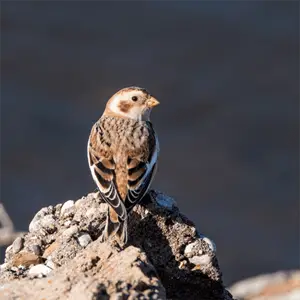
The snow bunting loves freezing conditions, primarily living in high latitudes in the Arctic tundra. But from December through February, they migrate to other chilly regions, including Alaska, which is the coldest state in the country.
Passerine birds, or snow bunting, have toes that are adapted for perching and have white inner wings and black-white tails. Sexually-mature females are white with brown backs, while males have black backs.
They can easily blend with the ground when walking leisurely, mostly in groups. If you happen to go outside in the miserable cold, you might find them rummaging through dirt for seeds or insects.
#22 Evening Grosbeak
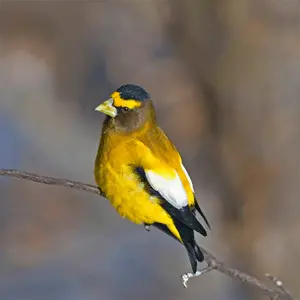
Evening grosbeaks are robin-sized with short tails and large bills. The adult males have bright yellow bodies and dark heads, while the females have grey on their dorsal parts, with green-yellow necks and flanks.
They are commonly found in flocks in backyards, nesting in treetops.
You can find these birds at any time of the day during winter, but mostly in the midwest regions, such as:
- Nebraska
- Iowa
- Minnesota
- North Dakota
- South Dakota
- Montana
- Wisconsin
- Ohio
- Indiana
They also inhabit parts of Idaho, Oregon, and California year-round.
#21 Common Redpolls
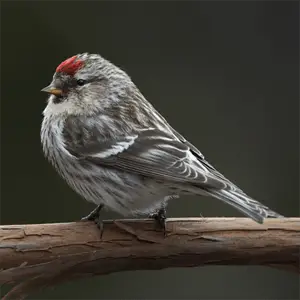
Common redpolls aren't so common in the Southern US, but if you live in the Northern US, you're more likely to find them. Subspecies of these birds, such as the mealy redpoll, breed in this region around south Canada.
They can tolerate low temperatures very well and primarily look for food when migrating to these regions.
As you'd have guessed, they have a small red forehead and pale red vest on their upper flanks and chest. However, brown and white are their most striking colors, with dark-tipped, somewhat yellow bills.
#20 Brown-Capped Rosy-Finch
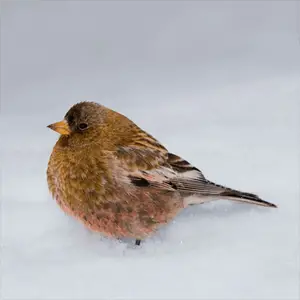
Among the mountain finches is the Brown-Capped Rosy-Finch, which is more common in Colorado than anywhere else. Sadly, this species is on the brink of extinction, so you won't get to spot many in your Colorado wild hunting.
But they're more ubiquitous during winter as they migrate to lower elevations. To confirm one, check its back, head, and breasts, as they must be all brown. They also have a pink belly, wings, and rump.
Note: If you find one, please don't harm or kill it. Don't scare them or approach their nest or young ones, but report your discovery to the local animal authorities.
#19 Northern Goshawk
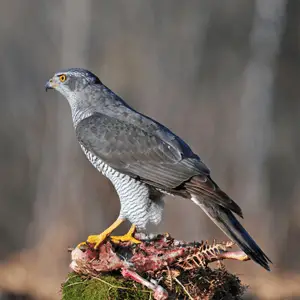
Size is certainly not a problem when spotting goshawks during winter, as they are the largest in the Accipiter family. They have dark heads with red to orange piercing eyes. Mature ones are dark gray, dorsally, and pale gray in their underparts, while immature ones are brown and streaky.
Northern goshawks also have long tails with broad, rounded wings that can appear pointed in a fight, while their sharp claws and curved beaks are adapted to grasp and kill prey.
In other words, these birds of winter can be pretty terrifying at first sight.
#18 Lapland Longspur
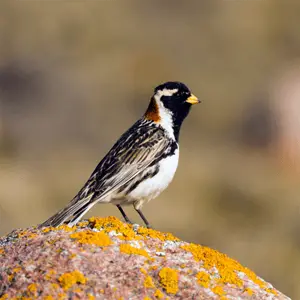
These species, also called Lapland bunting, are related to the snow bunting. However, their name implies they have more extended hind claws. They spend winter in the southern United States, among many other regions globally.
Seeds are their primary food source, so they might stop by your backyard if you fill a feeder.
They have dark tails covered with white feathers. The males have a more extensive black region around their faces and throats than the females, but both possess chestnut napes, white eye stripes, and underparts.
Females are slightly bigger than males, but both are between a sparrow and a robin in average size.
#17 American Robin
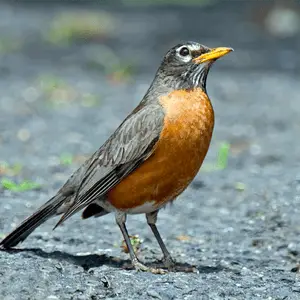
The American robin is the most abundant bird in North America, with over 370 million present. They prefer the southern region of the continent, including parts of the US like Texas, Florida, and Arizona.
You may have seen them during other seasons, as they're in open fields, golf courses, parks, gardens, tundras, and yards. They have dark heads, warm orange underparts, and gray-brown backs. You can distinguish the females from males with paler heads blending better with the gray back.
#16 Mourning Dove
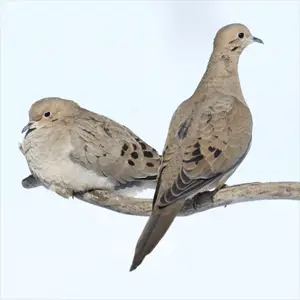
The American mourning dove, also called the turtle dove or rain dove, can be found in the winter. They occupy all over North America and, depending on each flock's primary home, migrate to more southern areas between December and March.
The ones you see during winter are probably from Canada and more Northern areas.
Mourning doves are medium-sized, like robins but bigger than sparrows, and are slender, weighing around 110 to 170 g (4.0–6.0 oz). They also have a delicate brown color with black spots on the wings and white tips on the tail feathers bordered by black.
#15 Northern Mockingbird
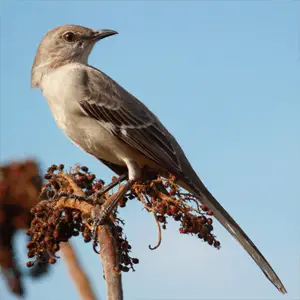
Northern mockingbirds are not fully migratory, so if you spot one in the summer or spring, it’s probably searching for cozy fires in the winter. Since studies from the 18th century, these birds have been known for their amusing mimicking abilities.
They are omnivores that enjoy munching on insects or plant products, from fruit flesh to seeds.
The mockingbird is medium-sized, gray to brown on their front region, with white wing bars on each wing. This feature becomes most visible when they spread out.
#14 Two-Barred Crossbill
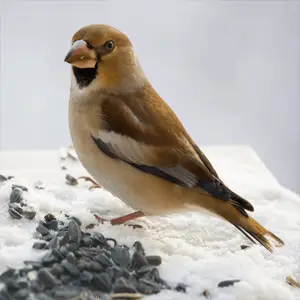
Two-barred crossbill or white-winged crossbill belongs in the passerine order, like the snow bunting, as its toes facilitate perching.
Being opportunistic breeders, as long as there is an abundant food source, they can begin nesting wherever they please. So, if they’re already present in your area and you want to see some every day during winter, buy a feeder and load it with conifer seeds.
These birds of winter are sparrow-sized or even smaller, with black and rose-pink feathers. However, young males and females are yellowish.
#13 Snowy Owl
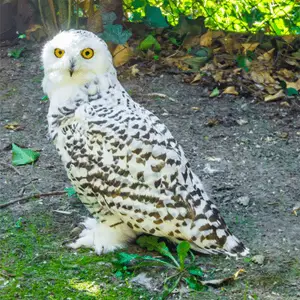
The snowy owl is a crow-sized avian with prominent snow-white feathers and yellow eyes. Black to brown spots are present in different areas throughout its body.
Like the Northern Goshawk, it'd be in your best interest to stay away from these birds' nests if you can reach them. However, they’re fascinating to sight from afar as they fly close to the ground.
You stand a better chance to occasionally spot them if you live in:
- Massachusetts
- New Jersey
- Pennsylvania
- New York
- Maine
#12 Mountain Chickadee
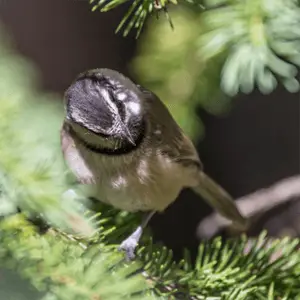
Mountain chickadees can be sighted year-round in the country's mountainous West and Southwest areas. But during winter, they go down mountain foothills, where you can easily see them.
They are tiny with black and white feathers on their head, and their wings and tail are primarily gray but may vary. The white stripe over mature chickadees’ eyes distinguishes them from younger ones.
Simply set up a nest box in your backyard to attract them, with some food and a guard to protect offspring from predation, if you want to see them.
#11 House Sparrow
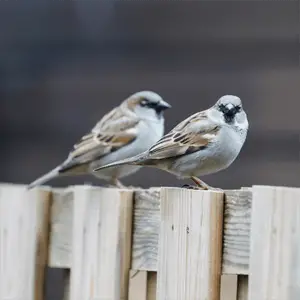
The house sparrow is one of the most popular birds globally. In the United States, they’re more abundant year-round in the Midwest, where wheat is massively grown. Those living in the mountains move lower as winter becomes more frigid, allowing you to see them.
Because they’re widespread throughout the globe, various adaptations cause appearance variations. However, in the US, check for a gray head, rufous neck, and black cheeks for confirmation.
These birds of winter have wings that are mostly brown-black.
#10 Pine Siskin
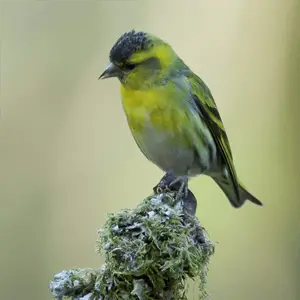
You can lure pine siskins with a feeder set in your backyard during winter, as they primarily search for nyjer or thistle seeds. You may want to pour enough if you want a pet for Christmas. You'll enjoy their chirpings when they've become accustomed to your home in no time.
They’re as small as sparrows with striking dark brown patterns, while their wings and tail tips are yellowish. They’ll be most visible when flying.
#9 Tufted Titmouse
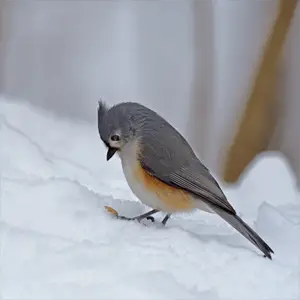
If you want to hand-feed birds, the tufted titmouse is audacious enough to dine on the seeds you present during winter.
They’re native to the Eastern US and inhabit deciduous forests year-round.
These tiny species have a small, round bill for cracking seeds and nuts. They also eat small fruits, berries, and insects. They have large black eyes on their silver-gray head, but their lower region is more white with orange flanks, and their blue feet are adapted for perching.
#8 Northern Cardinal
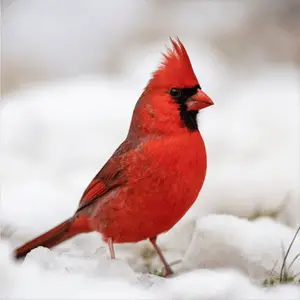
The northern cardinal is a songbird found nearly in all of North America.
Mature males are medium-sized with striking red feathers and black faces. However, females are pale brown, with slightly red tails and wings. They’re often in pairs on short trees and shrubs during this period, and their conspicuous appearance is highly advantageous when spotting them.
Although they are migratory, you can find them year-round in:
- Missouri
- Alabama
- Kentucky
- Tennessee
- Oklahoma
- Texas
- Florida
- Georgia
- Ohio
- North & South Carolina, and many others
#7 Dark-Eyed Junco
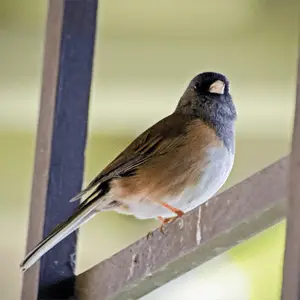
The dark-eyed junco is from the junco bird group, native to North America. They love freezing conditions so much that they migrate to the Arctic during summer but prefer wintering in the North and Midwest US.
They are all dark-eyed, but feather colors may vary by region. They weigh between 0.6 and 1.1 oz (18 & 30 g) and are around 5.5” - 6.3” (14-16 cm) long.
Furthermore, their identity is confirmed by a stout bill, round head, and relatively long tail.
#6 White-Breasted Nuthatch
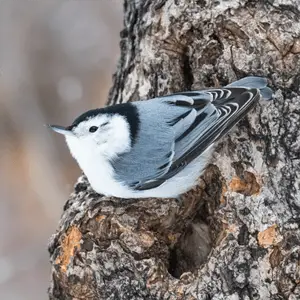
The white-breasted nuthatch is always ready to nest on your property throughout the holidays if you offer large nuts in bird feeders. Although they are the biggest nuthatch, they are as small as regular sparrows.
They have a large head, a barely visible neck, and a long, narrow beak. Their wings are gray-blue, but their face and stomach are white. Under their short tail is a brown chestnut, more visible at close quarters.
#5 Eastern Bluebird
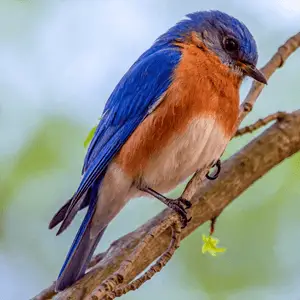
These birds winter down South, close to the Mexican border, but are available midwest year-round.
They’re deep blue with reddish dorsal regions from their throat to their breasts and have round heads, large eyes, and long wings. The eastern bluebird is about ⅔ the size of a typical American robin with short legs and tails and is attracted to berries and insects.
#4 Red-Winged Blackbird
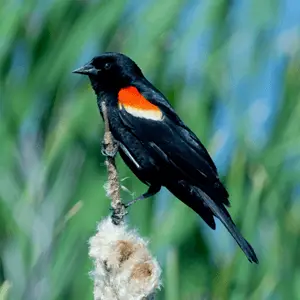
These species are passerines from the family Icteridae, most abundant in the US and other North American nations. They are around year-round, including winter.
They are medium-sized, weighing 1.1 - 2.7 oz (32 - 77 g). Their conical beak helps them crush seeds for food, and their tail is not too long or short. As suggested by its name, the blackbird is unmistakably black with a red-yellow patch on its shoulders.
#3 Varied Thrush
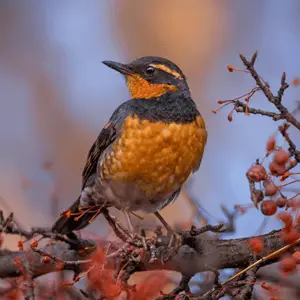
This multi-colored species found year-round in the United States is part of the thrush family. During winter, they move to lower elevations, where you can spot them easily from your snow-frosted windows.
They have long legs, round heads, and straight beaks for digging fruits and breaking seeds. Each varied thrush travels in flocks of up to 20 and weighs 2.3 - 3.5 oz (65 - 100 g).
#2 Northern Flicker
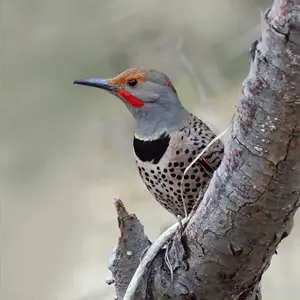
Northern or common flickers are woodpeckers native to some regions, including North America and the US. During winter, they move towards the southern side of the country.
From a distance, they appear brown, but on closer inspection or when flying, you'll see their yellowish wing and tail feathers. They also have black spots like polka dots. You'll also notice their head is round, and the bill is rather down-curved.
#1 Common Grackle
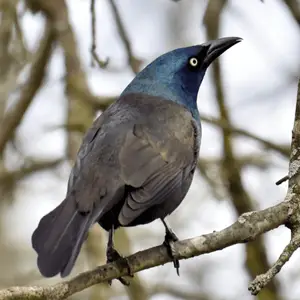
The common grackle is a North American avian that spends winter in the Southeastern United States. They have long legs and tails with flat heads, but unlike many bird species, the males are slightly larger than the females. Their head is glossy purple but isn't visible from far, and most other parts of their body are black.

Here's a few additional articles we've written which we think you'll enjoy...
- What Do Winter Birds Do In The Winter?
- How To Attract Birds In The Winter
Birds Of Winter...Final Thoughts
Whatever it is that causes some birds to migrate while others don't is still a mystery to this day. Yet, even though some birds are still out there even in the dead of winter, we encourage you to not only break out your binoculars for some winter bird watching, but to also leave your birdbath full of fresh water and your feeders full of seed.
Because you never know which bird from this list will show up!
Back To The TOP Of This Birds
Of Winter Page
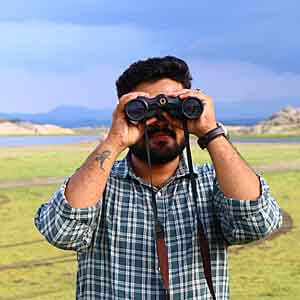
About the Author...
Richard Worden, a dedicated bird lover for over 20 years, I love to share my in-depth knowledge and passion for birds. Read more About Me and my expertise in this field.
- We Know Birds HOME ›
- Bird Facts and Information ›
- Birds of Winter
